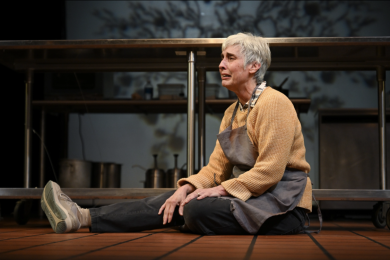Love, Stereotypes, and Craft
When checking my notes about the Guthrie’s production of “Under This Roof,” the first thing I saw was “Sound – amazing!” Katharine Horowitz's sound design is never obtrusive, but always wonderfully calibrated. Somehow the scratchy sound of a radio broadcast, the clanky ring of the big, black dial telephone, and the soft, slow shutting of an upstairs bedroom door, manage collectively to evoke the feeling of a post-World War II America (in this case, Cleveland in 1948), in which the technologies of modern life are not yet present, and the interplay of sound and silence generates a rhythm of daily life different from our own.
“Under This Roof” is a play about the human connections that can take place, despite the false paths that stereotypes and suspicions sometime lead us. It is also a play about mature, long-lasting, and luminous married love. That was the second thing I scrawled down: “crazy about each other.” I was referring to Raymond and Mamie Warren (Brian A. Grandison and Yolanda Bruce – both giving sparkling performances), a late-middle aged, working class African-American couple, who are struggling to cope financially following a serious accident that has left Raymond temporarily disabled. (“I fell off the damn roof!")
Raymond is a roofer, an expert in his craft who dreams of creating his own roofing business, but who, because of his race, is always given the most hazardous work.
He broke a rib and one of his legs. When he and Mamie were young and freshly wed, they had made the trek north from a small town in Alabama to Ohio, with high hopes for realizing the American dream – he was going to take care of her, and they were going to prosper. However, the exploitation of African-American workers and other aspects of the pervasive and structural racism have made “just getting by” a continual struggle. Even before Raymond’s accident, the couple was barely making ends meet. Now dependent solely on Mamie’s meager salary as a maid, it is clearly going to be a whole lot harder.
When first we meet Raymond, he is lying on the living room couch with a teapot-bedpan on the floor beside him. He is miserable. This is not a man who takes dependence, even temporary dependence, well. And he grumbles about Mamie’s having to spend her days “scrubbing toilets” for a wealthy white family. “You’re a teacher.” But teaching jobs for African-American women are rare in Cleveland and the two can’t both be out of work.
Their commiseration about social and economic injustice and the strife of “just getting by” is balanced with dialogue in which we glimpse the deep and luminous love that these two very well-wrought characters share. Barbara Kingsley’s portrait of seasoned marital happiness among 50-somethings is refreshing and it feels authentic. The playwright captures the shorthand that people who have lived together for decades use. You can hear the love in their banter, and even -- in undertones -- when they rant, scold, and argue. It is clearer still when Mamie says “yes but” [take your pill, try out the chair, etc.] and in the way that Raymond reminiscences about their courtship when he is alone or drifting off to sleep. Grandison’s eyes twinkle and his face lights up as he recalls the sheer “genius” of that “one brown button” on the dress Mamie wore that time. “Think of that! Just one!” Raymond remains in the state of enchantment that overcame him when he first laid eyes on a young Mamie swaying on a tree swing outside the neighborhood church some 30 years earlier. “In memory everything seems to happen to music,” Tennessee Williams once wrote. The play reminds us how our vivid memories of the earliest encounters with the person we love can enrich and sustain the building of a life together.
Rich and deep, their love is the one thing the two can count on. But almost everything else in their lives remains as uncertain and fragile as the roof that Raymond falls from. Mamie’s stingy white boss makes Mamie pay for a cab to her employer’s house when she runs late. She is wondering how she is going to get through “Thursday”- or even one more day. Mamie can’t quit her job, so she asks a friend from church if she knows “a girl” who can look after Ray while she works and do so for the few pennies Mamie can spare from her own low wages. The “girl” – Bessie Washington (Laura Esping) -- arrives, and to the shock of the Warrens, she’s white. What’s more, she is well dressed and she wears nice jewelry. Mamie is very suspicious, but cannot investigate right away, as she needs to rush to work.
Kingsley does a wonderful job portraying the kind of subtle intimacy that can develop between strangers thrown together in unexpected circumstances. At first, Raymond won’t even speak to Bessie and he won’t cooperate: he puts the blanket over his head when she arrives, he won’t take his pills, he won’t tell her what he needs (unless it’s a cigarette), and he snaps at her whenever she tries to ask a question. At one point, he answers her so harshly that Bessie breaks into tears. But then a man’s got to eat, so when she asks if she can make him breakfast – “a poached egg, perhaps?” -- he bends. A little. No, not a poached egg; he wants “flap jacks” (Bessie is white enough not to know that he means pancakes). She asks for instruction; Kingsley writes a very funny scene in which Bessie’s offstage (in the kitchen) and Raymond shouts out step-by-step instructions on how to make flap-jacks: where to find the Bisquick, how to make the batter, where to find the corn, the oil to grease the pan, find the molasses, etc. Espling and Grandison, both sophisticated comic artists, give the sequence a Chaplinesque feel.
Food, of course, is a famously great way of melting ice and breaking down boundaries. The breakfast tray that Bessie brings is lovely, with perfectly round pancakes and a flower in a cup. But when she sets the tray down on the table, it turns out Raymond can’t sit up to eat. That’s when we first glimpse Bessie’s other dimensions –her skill and talent for nursing. Espling is tiny, about half the size of Grandison. But when she positions her chest behind him and tells him to put his weight back on her, at which point she swiftly and effortlessly shifts him to a sitting position. Raymond’s amazed: “How did you do that?,” he asks . And when a few minutes later Raymond undergoes a spasm of severe pain, the Bessie who had initially appeared so prim and nervous and sensitive transforms. Suddenly she is bold and self-assured, giving her patient instructions and using her massage skills to calm the spasm, and make the pain disappear.
We come to realize that Bessie and Raymond are both artists, artists of repair. Bessie is nearly magical in her ability to heal pain, and Raymond is an expert in nesting a roof. Nesting, we learn, involves patching a worn roof by putting on an extra layer of tiles. In a great scene, Bessie keeps prodding Raymond with questions about his craft, and, mostly to stop her badgering, he responds with detailed explanations of how roofs work. In this, he reveals the extent of his expertise. Bessie realizes that getting Raymond to talk about his work and recall his mastery is conducive to self-esteem, and that, in turn, is necessary for healing
Esping’s performance as Bessie shows superb emotional eloquence. Bessie handles objects with great care; a glass or plate become meaningful in her hands. We see the caution with which she places a cup on a table and how her eyes linger on it a moment to make sure it doesn’t fall. And we observe also the precision with which she smooths her skirt or claps shut her purse; we are given to understand that such cautiousness is symptomatic of risk-aversion. Bessie feels that if she can just control the objects around her, then maybe she can have some control over the people and the things that really matter to her.
Bad luck, the weight of injustice, an unexpected, unwanted change of circumstances can have a special sting for people who place great value on self-sufficiency and autonomy. Helplessness, a certain degree of neediness is what we have in common to greater or lesser degrees and yet for people like Bessie and Raymond needing help, needing kindness from others is a source of painful embarrassment. So, Raymond dodges questions about his life and Bessie makes up false answers about hers – answers that don’t fit together. Sharp people like Ryamond and Mamie are reasonable to suspect Bessie of hiding something.
Secrets are slowly revealed. It turns out that Bessie’s husband died in a car accident two week earlier, but she didn’t attend the funeral because they’d stopped caring about each other years before. Bessie had a horrible marriage; her husband slept around (they found his body next to his mistress). The husband had worked for a mobster who claimed all his assets when he died. That is how you can have nice jewelry and still be desperate for work.
Meanwhile, Bessie’s mother-in-law is trying to get custody of her son, Mason Mueller (Nathan Stenberg), a young man with a severe disability. The mother-in-law’s plan is to put Mason into an institution. Bessie will do anything to keep her son with her; he is her life “and he’s enough.” Mason, in turn, knows who he is, and he knows how other people see him: as something less than a person. The bond between mother and son is profound and it is moving.
The other standout here is Stenberg as Mason Mueller. Stenberg’s physicalizing of the character is exquisitely calibrated and his performance, though brief, is arresting. This is Stenberg’s Full Circle/Guthrie debut (he is a recent transplant from New York) and he’s a talent to be reckoned with.
One matter that needs to be noted and praised about “Under This Roof” is the use of an actor (Stenberg) with a disability to play a character with a disability. This is a much-needed exception to the general standard of discrimination against actors with disabilities (See Erin Robert’s piece on this subject) and it is hetaeristic of the sensitivity to issues of inclusion and representation that this marvelous company continues to model for Twin Cities theaters.
There are a few small concerns about the play. First, too often, and especially in the first ten minutes, Kingsley takes a short-cut in setting up the background by packing exposition into the dialogue. This inevitably feels artificial (a long-married couple do not start each day with vocal summaries of their immediate situation) and it undermines the realism that she achieves later on in the play. Second, the play is more effective when it remains thematically modest. It is less so when Kingsley reaches for bigger themes. Some of the pithy reflections uttered by the characters as Kingsley winds up the narrative - “When you feel like you’re in the deepest hole and then you find someone who is lower than you” -feels forced. When you have a play surfeit with moments of authentic human connection such commentary is unncessary. “Under the Roof “is sufficiently meaningful in those particular unspoken ways that only theater allows. It’s lovely.




